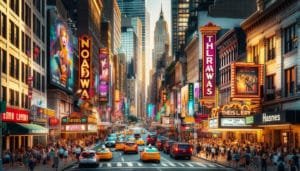A cartoon-style depiction of New York City’s Broadway, featuring exaggerated, colorful elements characteristic of cartoons. The scene includes vibrant neon signs of theaters and billboards, with cartoon-like characters walking on the streets. These characters range from caricatured tourists with cameras to exaggerated local New Yorkers. The street is bustling with cartoon yellow taxis and stylized red double-decker buses. The buildings display a whimsical blend of modern and historical architecture, under a bright, cartoonish sky.”>

Broadway, often considered the pinnacle of American theater, is renowned for its rich history and the diversity of shows it hosts. Situated in the heart of New York City, Broadway refers to the theatrical performances presented in 41 professional theaters, each with a seating capacity of 500 or more, located in the Theater District and along the street of Broadway.
History and Evolution
Broadway’s origins date back to the late 18th century, with the opening of the Park Theatre in 1798. Over the years, it evolved from vaudeville and operetta to the modern musicals and dramas that dominate today. The 20th century, particularly the 1920s and 1930s, saw a boom in Broadway theater, with shows reflecting the themes of the times.
Iconic Shows and Genres
Broadway has hosted a variety of genres, from dramas and comedies to musicals. Iconic shows like “The Phantom of the Opera,” “Cats,” “Les Misérables,” and more recently, “Hamilton,” have left indelible marks on the landscape of theater. These shows are not just commercial successes but have also influenced popular culture and the arts globally.
Impact of Technology and Modern Trends
The advent of technology has had a significant impact on Broadway. Advanced sound and lighting systems, elaborate stage designs, and special effects have elevated the theatrical experience. Moreover, contemporary themes, diverse casting, and innovative storytelling reflect the changing dynamics of society.
Broadway’s Economic and Cultural Impact
Broadway is a significant contributor to New York City’s economy, attracting millions of tourists annually. It’s not just an entertainment hub but also a cultural melting pot, where stories from across the world find a stage. The industry supports thousands of jobs, from actors and directors to stagehands and marketers.
Challenges and the Future
Despite its success, Broadway faces challenges like the high cost of production and tickets, making it less accessible to a wider audience. Additionally, the COVID-19 pandemic brought unprecedented challenges, leading to a temporary shutdown of theaters. However, the resilience of Broadway is evident in its ability to adapt and evolve, whether through digital performances during the pandemic or embracing new forms of storytelling.
Conclusion
Broadway remains a symbol of theatrical excellence, reflecting the ever-changing narratives of society. Its ability to adapt, evolve, and enchant audiences makes it a timeless testament to the power of live theater. As it continues to overcome challenges and embrace new opportunities, Broadway’s role in shaping the cultural fabric of not just New York City, but the world, remains unchallenged.